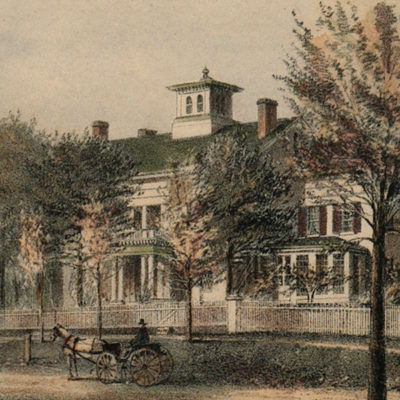
This summer I moved to Amherst, MA, a beautiful and vibrant town with a rich history. One of Amherst’s most famous residents was the American poet, Emily Dickinson. Once I started to explore more of Amherst, I immediately noticed Emily Dickinson’s imagery and influence over the entire region. The most noticeable example is the Dickinson Historical District, which houses two of the prominent Dickinson houses: the house where Emily Dickinson was born, and her brother Austin’s house that he built in 1856. They are both now part of the Emily Dickinson Museum, maintained by the faculty at Amherst College. Artwork and imagery of Emily Dickinson can be seen all around the village, including near the West Cemetery where she is buried and on various buildings, signs, and even electrical boxes. Dickinson Street, which begins near her family’s homestead and terminates near a side entrance of Amherst College, is also named after her.
As a result, I became very interested in the life of Emily Dickinson and wanted to know more about her life in Amherst. I decided to watch a movie that came out in 2018 called Wild Nights With Emily. It is told from a comedic approach towards Emily’s struggles in trying to get her poems published and of her life-long secret romance with her best friend, Susan, who eventually marries Emily’s brother Austin. I really like how the movie tried to uncover Emily Dickinson’s life from an unique perspective that was untainted by modern stereotypes of her personality. Her characterization was summed up by a quote that appeared at the end of the movie: “To this day the myth persists of Emily Dickinson-one of the only women in the canon-as a half-cracked, unloved recluse who was afraid to publish her work.” Instead of portraying her with the common characteristics that are arguably unjustly associated with her, the movie portrayed Emily as a loving, persistent, funny woman who was passionate towards life and her lover Susan.
After watching the movie, I wanted to visit Emily’s family grave and her home. Downtown Amherst’s West Cemetery is a well preserved monument that holds not only Emily’s grave, but also that of her relatives including her father, grandfather, and sister. Although protected and preserved by the state of Massachusetts, it is not very noticeable at first glance. The entrance is very easy to miss since it is located behind a row of stores and restaurants. Visitors may have to locate it on Google Maps in order to find the exact location. At any rate, once I was inside the cemetery, it didn’t take a long time for me to find it because only the Dickinson family graves were rounded off with an old-looking fence. Emily’s grave in particular had various rocks and dedications that adorned her headstone, some also being present on her sister’s too. I also tried to find Susan Dickinson’s grave, but it wasn’t there. After searching online, I found out that Susan Dickinson’s grave was actually located in a different location called Wildwood Cemetery which is located near the Amherst Regional High School. After more extensive research, I made it out towards Wildwood the next day and finally walked to a quiet, quaint section of the graveyard. Before me was the grave plots of Susan and Austin Dickinson’s family, which also included some of their children. Another interesting thing to note was that Mabel Todd, the mistress of Austin Dickinson and the person who published Emily’s poems after her death to widespread acclaim, was buried only a few plots over from Susan’s. It must have been awkward at first to see both families, entangled in love affairs, pay their respects in such a short walking distance.
Unfortunately, because of the current coronavirus quarantine, the museum building was closed towards visitors. However, the grounds and surrounding gardens are still open, and I could walk through the beautiful hemlock hedge entrance to see a well preserved homestead. Even though I couldn’t actually go inside the houses themselves, the scenery was beautiful enough that it left a touching impression. It must have been a calming scene for Emily to see, especially when she was thinking up more subjects for her poetry.
Overall, it was quite enlightening to dive into the life of Emily Dickinson because it led me to cast aside various summaries about her that were filled with only a dim view of the woman behind the pen. Susan was clearly her muse, the subject that emboldened her to write many poems concerning love, freedom, and loss. More research should go into the life of Susan Dickinson as well if we are to understand many of Emily’s poems. Emily was also very protective of her work, seeing confidence in what she was doing in an era where her style of poetry, with one major unique characteristic being that her poems were always untitled, was seen as very eccentric and “unpolished”. If you go to Amherst, you can clearly see how Emily has influenced the community and has empowered many women to try out whichever lifestyle they want to pursue. Her reputation is regarded so highly that in recent years, petitions to rename Amherst (named after the British officer Jeffery Amherst, who is seen as problematic due to his insistence on using smallpox to eradicate Native Americans) to “Emily” have become almost common occurrences. She is definitely worthy of being a role model for young women who aspire to be whatever they want to be.
-Mengshu Ye
Junior Girl
Girl Museum Inc.
